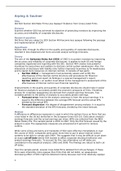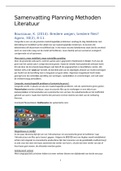Title
Did SOX Section 404 Make Firms Less Opaque? Evidence from Cross-Listed Firms
Purpose
Examine whether SOX has achieved its objective of protecting investors by improving the
accuracy and reliability of corporate disclosures.
Research question
Did firms that are subject to SOX Section 404 become less opaque following the passage
and implementation of SOX?
Hypothesis
Section 404 -through its efect on the quality and quantity of corporate disclosures-
resulted in less dispersed and more accurate analyst earnings forecasts.
Theory
The aim of the Sarbanes-Oxley Act (SOX) of 2002 is to protect investors by improving
the accuracy and reliability of corporate disclosures. It applies to both US and foreign
companies registered and reporting with the SEC. Section 404 creates new powerful
incentives for executives and auditors to disclose control system weaknesses. Also, the
interaction of disclosure with liability risks further improved incentives to fix weaknesses
and to spend more resources on internal controls. It consists of two parts:
Section 404(a) = management must personally assess and certify the
efectiveness of the internal control structure and procedures for financial
reporting and must report its findings in a special management’s report.
Section 404(b) = an auditor must attest to the management’s assessment of the
efectiveness of internal control over financial reporting.
Improvements in the quality and quantity of corporate disclosures should make it easier
for financial analysts to accurately predict the economic prospects of firms. Therefore,
proxies for corporate opaqueness are derived from analyst earnings forecasts. Two
variables pertain to the ability of analysts to accurately predict earnings:
Forecast error: how far the analyst consensus is from the actual earnings. It is
equal to the diference between the average ESS forecast and the actual ESS,
divided by the actual ESS.
Forecast dispersion: the degree of disagreement among analysts. It is equal to
the standard deviation of the ESS forecasts, divided by the mean forecast.
Method
A diference-in-diferences regression is used in which the authors focus on firms that are
cross-listed in the US but domiciled in the European Union (EU-15). Data about analysts’
earnings forecasts and the actual earnings per share (ESS) are collected from the IBES
Detail History file. The sample period is 2001 to 2007. Only the first forecast issued by the
analyst is used. The opaqueness measures are winsorized at 5 percent to remove
outliers.
While some of the provisions and mandates of SOX were efective immediately or over
the course of 2003, companies were given more time to put in place internal control
systems to be able to comply with S404. This suggests that it may be difcult to pin down
an exact cut-off date where SOX started to afect corporate disclosure behavior and
analyst earnings forecasts. To account for this, two alternative cut-of dates are
considered in the empirical analysis: 2005 and 2006. The findings are robust to both cut-
of dates.
Over the sample period, several cross-listed firms delisted from US exchanges. If these
firms were inherently more opaque than firms that did not delist, an opaqueness-
decreasing efect of SOX might be detected merely because over time relatively opaque
1



